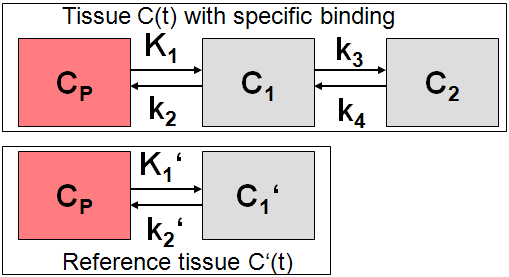The measurement and analysis of the blood samples for kinetic modeling is an invasive and demanding procedure. Therefore, methods have been developed to obviate the need for invasive blood sampling. The solutions found replace the arterial input curve by an indirect input curve, namely the time activity curve of some reference tissue. Therefore they are called reference methods. Reference methods are not able to provide a full kinetic analysis. However, assuming certain relations between the kinetics of the tissue of interest and the reference tissue, they can provide valuable measures of interest.
Most of these reference methods are dedicated to reversibly binding neuroreceptor tracers. A reference tissue must be found which is devoid of receptors, and then it is assumed that the distribution volume of the non-displaceable compartment (free tracer in tissue and non-specific binding) is the same among the tissues. Under these assumptions a measure of the receptor concentration called binding potential can be calculated from the two time-activity curves.
PKIN features the following list of reference models:
Model Name |
Description |
4 Parameter Reference Tissue Model by Lammertsma et al. |
|
Simplified reference Tissue Model by Lammertsma and Hume |
|
Modification of Simplified Reference Tissue Model modified by Wu and Carson to reduce BP bias induced by noise |
|
Multilinear Reference Tissue Model by Ichise et al. |
|
Multilinear Reference Tissue Model by Ichise et al modified to reduce bias induced by noise |
|
Multilinear Reference Tissue Model by Ichise et al modified to reduce bias and variability induced by noise |
|
Reference tissue method which is based on an average k2 |
|
2 Tissue Reference Model |
Watabe's reference tissue model with a 2-tissue compartment model in the reference region |
Multi-linear Reference Tissue Model for [11C]-MP4A (RLS) |
Model Structure
The compartment models are usually based upon the following configuration:

In the model equations C'(t) represents the TAC from the reference region (k3=0 in the 2-tissue compartment model), and C(t) the TAC from a receptor-rich region (k3>0).
However, the various reference methods differ in their mathematical approaches, and they show substantial differences with regard to noise sensitivity and processing speed. They are described in the following sections.